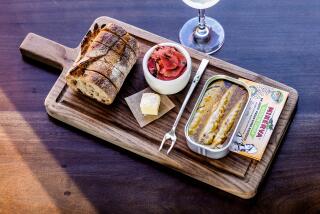Buried Treasure
- Share via
Say “salt cod” and some will think of the garlicky pureed brandade de morue of Provence, or perhaps the even punchier, more luscious Venetian version, baccala mantecato. For me, salt cod, or dried saltfish, conjures childhood memories of San Francisco and the fishy flavors served up by my formidable Italian grandmother--Nonna Clelia. Small and wiry, Nonna spent most days in an apron running the kitchen, a room my father avoided. She never learned English and rarely ate American food. Like many transplanted Italians, she craved baccala, especially on Fridays--the day of the week on which Catholics avoid meat, and when salt cod appears on dinner tables up and down Italy’s boot. It’s typically prepared with tomatoes, potatoes or piquant sweet-and-sour sauce, according to scores of regional recipes. Nonna came from the Venice area and knew its cod-rich cuisine. She spent much of her adult life in Rome, where my father, a meat-loving GI from Garden Grove, first met my mother in the ‘40s and experienced my grandmother’s baccala.
Italians describe someone who’s uptight or frozen stiff with anger as “rigido come un baccala.” That’s because cod, for centuries a mainstay throughout Europe and parts of North America, becomes rigid when air-dried and salted. It is also remarkably pungent. Before transforming the fish into something delicious, you must first soak it for days in many changes of cold water. The salt washes out, and so does the fishy smell.
In Rome, Nonna always bought her cod pre-soaked for immediate use from delis, where the demand was high. But in San Francisco’s North Beach Italian neighborhood, demand was lower, so the salt cod was board-stiff and stinky. Shortly after settling into our Victorian row house, Nonna ventured down to North Beach and returned bearing a three-foot baccala. She plunged it into an old baby bath in the basement. Soon the house was filled with fishy scents. Nonna had marked her territory.
When my father got home that evening, he began to curse. We heard his footsteps pound up the wooden staircase from the basement. Carrying the bathtub, he teetered through the kitchen and into the backyard, where he dug a hole big enough to hold little Nonna. He then ceremoniously laid the limp cod into it, tamped down the soil and marched away muttering “not in my house.” Nonna stood stiff as a baccala. She never dared soak salt cod again, but she often smuggled it home, already cooked in someone else’s kitchen. And she bequeathed her salt cod passion to at least one grandchild.
Salt cod is an expensive delicacy these days, widely used in Caribbean, Asian and Mediterranean cuisines. You can still buy it stiff, dry and smelly from Italian specialty shops. But it’s also imported semisoft from Canada and sold in nifty little wooden boxes at many supermarkets. Practically odorless, you need only soak this Canadian-style cod overnight in the fridge to wash out the salt.
In my own kitchen, I love nothing more than devouring platefuls of mouthwatering salt cod fritters, pastes or stews. And I always think of Nonna.
*
Roman-Style Salt Cod With Tomatoes, Raisins And Pine Nuts
(Recipe adapted from Alberto Ciarla, Rome)
Serves 4
2 pounds pre-soaked salt cod
1 cup flour
1/2 cup extra virgin olive oil
2 cloves garlic, peeled
a pinch of salt
Freshly ground black pepper
3/4 cup dry white wine
4 cups (about 2 pounds) peeled and seeded ripe Italian plum tomatoes, or 1 28-ounce can whole peeled tomatoes with juice roughly chopped
1/2 cup raisins soaked in warm water and drained
1/2 cup pine nuts
Rinse cod in cold water. Place cod in large container and cover with water. seal container and refrigerate for 24-36 hours. Change water several times a day. Rinse fish before using. Bring large-sized pot of water to boil, add codfish and blanch for 1 to 3 minutes. Remove skin and any bones. Cut codfish into 3- to 4-inch strips. Tamp the strips dry with paper towels. Pour flour into shallow bowl and dredge codfish strips through it, coating both sides. Pour oil into large frying pan and heat over medium flame until bubbling. Add the garlic and brown, 2-3 minutes. Discard garlic. Lower cod strips into oil and fry until golden, turning twice and sprinkling with salt and pepper, 3-4 minutes. Transfer fried cod to drain on paper towels and discard excess fat. Pour wine into pan and stir until alcohol evaporates, 1-2 minutes. Add tomatoes, raisins and pine nuts. Bring sauce to simmer and cook, uncovered, for 15 minutes. Gently lay fried cod fish on top of sauce, lower heat to minimum and cook, uncovered, for 5 minutes. Serve codfish on pre-heated plates and spoon sauce over fish.
*
David Downie’s latest book is “Cooking the Roman Way: Authentic Recipes from the Home Cooks and Trattorias of Rome.”
More to Read
Eat your way across L.A.
Get our weekly Tasting Notes newsletter for reviews, news and more.
You may occasionally receive promotional content from the Los Angeles Times.








